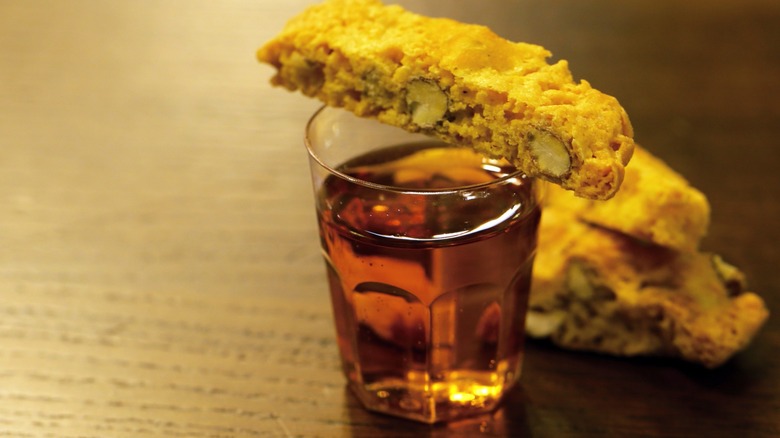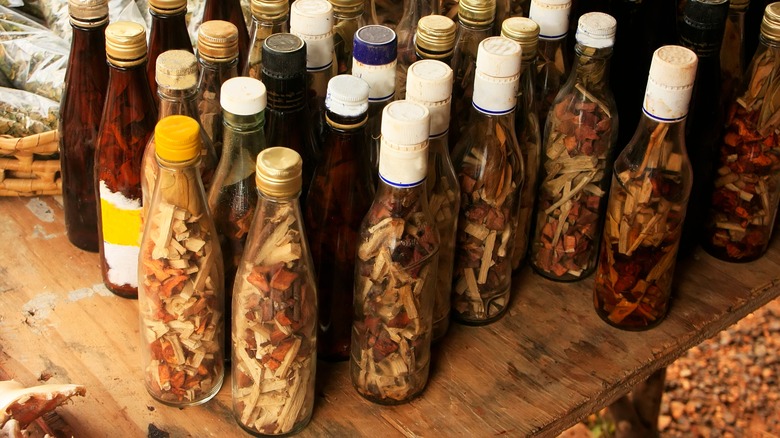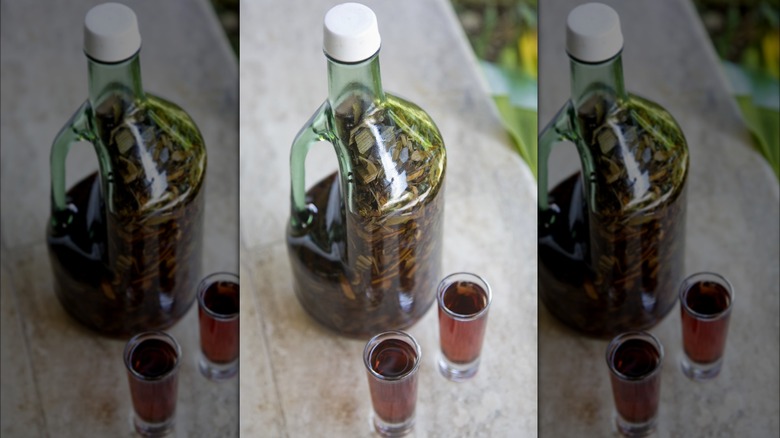What Is Mamajuana, And How Do You Sip The Dominican Drink?
Mamajuana (aka mama juana or damajuana) is a type of spiced rum from the Dominican Republic. The liqueur typically comes in a big glass bottle filled with large pieces of bark, roots, and floating plant matter steeping in a mixture of rum, wine, fruit juice, and honey. Its name comes from the glass bottle in which it's typically housed, which is large, short-necked, and often wrapped in wicker. The term is borrowed from the old English word "demijohn."
The drink's flavorful botanicals frequently include — but are not limited to – tree bark, twigs, roots, wood chips, and whole spices like basil, bitter ginger, cinnamon bark, maguey leaves, sarsaparilla, star anise, and cloves. The result is a spirit with a warming, sweet, fruity, and spiced profile. Some folks use port instead of wine for a smoother finish.
Owing to its colorful mix of infusions, mamajuana has a vivid hue that ranges from amber to bright red and clocks in at a punchy 30% alcohol by volume (ABV). For reference, full-strength tequila has an ABV of 40% and California pinot noir has an ABV of about 14%. Regardless of the vast variations, mamajuana always contains three main ingredients: Dark rum, botanicals, and sweetener. Recipes vary by region and are often deeply personal.
Mamajuana is also an elixir for the ages
Mamajuana is enjoyed as an alcoholic beverage, but it's also regarded as medicine. It's believed to help treat impotence, joint pain, arthritis, the common cold, and inflammation and improve long-term memory and neurological functioning. Many feel that it also cleanses the blood, liver, and kidneys, aids digestion and blood flow, and may even help prevent cancer. Common medicinal ingredients include guayacán wood, anamú leaves and roots (taken from the petiveria shrub), mauby bark, and palo de Brasil and bejuco de Indio wood.
In this way, mamajuana is an essential part of the Dominican Republic's culture and heritage, with a history dating back nearly 500 years. The Taíno, the indigenous people of Hispaniola, have been using mamajuana to treat various ailments since before the Dominican Republic was colonized in 1493. But it wasn't until the 1950s that mamajuana gained its cemented popularity in the Dominican.
A traveling salesman named Jesus Rodriguez promoted his version of the drink with the marketing help of the merengueros Dominicanos — a group of beloved (and subsequently influential) musicians — and now mamajuana is a daily sipper for many folks in the D.R. The country's official tourism website, Visit Dominican Republic, calls mamajuana "arguably the most important national drink of the D.R. after rum." It's traditionally a homemade drink but is also served in many bars across the country. Many Dominican households even consider making your first batch of mamajuana to be a rite of passage.
However you sip it, let the botanicals speak for themselves
For such a complex beverage, mamajuana doesn't exactly have a designated drinking ritual. When the Taínos were first brewing the liqueur as a healing cure-all elixir, they mixed it with herbal tea before drinking it. Today, locals drink their mamajuana straight-up at room temperature or chilled with two ice cubes, and never on an empty stomach. (It would pair well with biscotti or a Dominican cigar.)
Straight-up is the best way to fully appreciate the liqueur's complex profile, but it can also be used as a flavorful ingredient in cocktails like a dark Manhattan or a spiced mojito. Mamajuana can even be enjoyed warm, like mulled wine. The flavor-packed liqueur is becoming more popular internationally and can now be found at places like Costco and Total Wine in the U.S. It doesn't need to be refrigerated, and thanks to how smooth it goes down, it's often sipped slowly or slammed back as a shot — a daily practice that is common in the D.R. to regularly take advantage of mamajuana's many health benefits.


